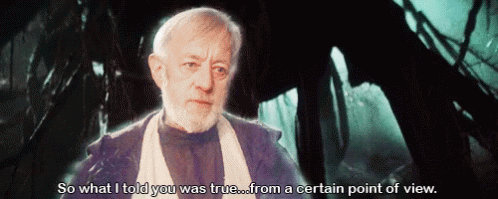The Writing Craft – Talking about POV

This week on the blog, I thought I’d discuss points of view (POV). This is probably one of Obi Wan Kenobi’s most famous quotes, talking to Luke Skywalker about *that* particular spoiler. It’s a fascinating example of how much storytelling can differ, depending on who is telling it.
So, what are the different types of POV and how might you decide which POV is best for telling your story?
1. First person POV

This is one of the most common narrative points of view, using the ‘I’ pronoun as the narrator tells their story. The reader is inside the narrator’s mind and the narration is typically contained to their thoughts, experiences and reactions to what is going on around them.
The narrator is typically the main character, e.g Jane Eyre by Charlotte Bronte. However, this is not always the case. For example, in The Great Gatsby by F. Scott Fitzgerald, although the novel is narrated by Nick Carraway, Gatsby is the protagonist.
The great advantage of first person POV is it really lets you into the narrator’s mind and you get to know that character’s motivations, providing a unique insight. It also gives the potential for exciting plot twists, if an event has happened differently to how the narrator has described it, as the reader is limited by the way the narrator perceives reality.
2. Second Person POV

In second person POV, the narrator is addressing the reader directly, done using the ‘you’ pronouns. They draw you into the world of the book by assuming you, too, are a person within the world of the novel.
Second person POV may be used occasionally within the first person POV, especially if the narrator is recording their thoughts like a diary or letter For example: “I told you, dear reader, how I went to the restaurant last Saturday. What I did not tell you, though, was..”
Although second person POV can be used in poetry or short stories, it is far less common used in novels. The most well-known example is probably Bright Lights, Big City by Jay McInerney in 1984.
The advantage of second person POV is its unique ability to make the reader a character in the story. For example in a murder mystery, ‘you’ might well be a guest at the dinner party. Perhaps the narrator might even accuse ‘you’ of hiding something, or even being a murderer.
Of course, the main reason second person POV is so rare in novels is because it is extremely difficult to use that narrative devise for so long. Using the ‘you’ pronouns has a high chance of being repetitive and confusing. The reader also may really not like their character, as the narrator is telling them who they are and the kinds of decisions they might make.
3. Third person POV
Along with first person POV, Third person is one of the most common narrative devices. Third person narration tells the story from a particular charater, but the reader is not inside the character’s mind, using pronouns such as ‘he’, ‘she’, ‘they’ or ‘it’. Third person has the advantage of knowing a character or characters quite well, but also being able to see the situation outside of the characters.
There’s also a distinction within 3rd person POV:
Third person omniscient

As you might guess from its title, third person omniscient is where the narrator is all-knowing. In this device the narrator has a bird’s eye view of t least some things outside of what the main character would know. They might be able to tell you where other characters are who might be very far from the main character. For example, “while Bob was busy at the party, he didn’t know that Sarah was already at the lake.”
The narrator is also free to tell the reader what the other characters were thinking, e.g. “Bob didn’t realise that Sarah was thinking of leaving”. A classic example of third person omniscient would be Pride and Prejudice by Jane Austen, where the narrator tells the reader the thoughts and reactions of both Elizabeth Bennet and Darcy.
Third person limited

If third person omniscient is where the narrator is all-knowing, then third person limited is when the narrator is bound to the thoughts and feelings of a particular character. In this way it can feel fairly similar to first person POV. The reader is only seeing the world as perceived by the character. E.g. ‘Fred’s eyes narrowed, but Sally couldn’t understand what she had done.” A classic example of this would be 1984 by George Orwell.
You decide
So, that’s a brief look at the different POV the writer can choose to tell their story. How do you decide? Well, that’s up to you and what is best for your story. Perhaps write a couple of scenes experimenting with different POV and see how it feels.
It might well depend on the genre and the style you are going for. For example my historical fiction novels, ‘The Boy from the Snow’ and ‘The Veiled Wolf’ are both set in 1st person POV, whereas Lottie’s Locket is set in 3rd person limited. (PS sign up to my newsletter here or below to claim your free preview of Lottie’s Locket!)
One other thing is that your POV could switch between characters. For example, I thought the fourth in my historical fiction novels (which I’ve only just started writing) would be told solely from the point of view of Imogen, a character in my 2nd and 3rd novels. However, it seems I’m not done telling Daniel’s story yet, as I’m now thinking I will split the 1st POV between Daniel and Imogen. Of course ‘head hopping’ needs to be done carefully and not too often, so not to confuse the reader. Ultimately, who tells your story is up to you.
Till next time, Maria 🙂

Lovely post!
I’ve always wanted to be able to pull off a novel in second person.
Thank you! Yes, it’s certainly tempting! Especially since mentioning the example of a murder mystery… 😆😊
Writing is such a gift, and it should be cherished. Great post!
Miamii 🙂 x
Thank you so much! I quite agree 😁
Great post! I’ve shied away from 3rd omniscient because a developmental editor told me that I was head-hopping, and I didn’t understand the difference between character thoughts and narrator thoughts about the character thoughts. I may try 3rd limited again in the future, but for now, 1st past tense is working for my books.
Head hopping can be confusing! I’m experimenting at the moment with a split POV between Daniel, my MC from my 1st 3 historical fiction novels & another character, Imogen. It was going to be purely from Imogen’s POV but I felt like Daniel hadn’t finished with telling his story yet. 🙂
Thanks for sharing, I’ve never know what second-person narrative actually meant (and I was too lazy to look it up lol). A very interesting guide – which is your favourite to employ? I find I lapse into third whenever I’m planning, but prefer writing in first person
Thank you! Glad it was helpful. It depends on the story but I tend to go for either 1st person (my historical fiction series) or 3rd limited (my fantasy/mystery novel for older children and adults).😁
One mistake I often see us Indie Authors make, is writing in 2nd p POV and disguising it as 3rd p POV. I often refer to this as ‘preaching’. Most often, the author has a point they’re trying to getting across or wanting to convince the reader of something. It’s not strictly a POV issue, but easiest to describe using POV. If you catch yourself doing it consistently in a story, you may want to rethink your POV.
Hi Frankie, thanks for your comment. Good tip, it would be interesting to see more of what you mean/what ‘preaching’ looks like in practice.😁